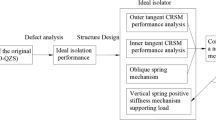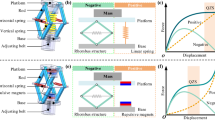Abstract
A quasi-zero-stiffness (QZS) vibration isolator is an ideal device for low-frequency vibration isolation. However, its stiffness increases steeply against the displacement, which renders a QZS isolator to be less effective in an ultra-low-frequency range. Aiming at solving this issue, a new nonlinear ultra-low-frequency vibration isolator with a dual quasi-zero-stiffness (DQZS) mechanism is put forward by combining two subordinate QZS mechanisms with a vertical linear spring in parallel. The subordinate mechanism itself has a QZS feature, which provides negative stiffness along the vertical direction through an oblique link rod. The parameter design of the isolator is carried out to fulfil quasi-zero stiffness, which shows that the stiffness–displacement curve is much lower and more flat than the traditional QZS (TQZS) isolator in a wide displacement range. The dynamic behaviours of the DQZS vibration isolation system (VIS) are determined by employing the harmonic balance method, and the vibration isolation performance is evaluated by using theoretical, numerical and experimental transmissibility. It shows that both the beginning frequency of the vibration isolation and the peak transmissibility of the DQZS VIS are lower than the TQZS isolator, which indicates better vibration isolation performance of this ultra-low-stiffness DQZS VIS.















Similar content being viewed by others
References
Preumont, A.: Vibration Control of Active Structures. Springer, Cham (2018)
Zou, Y., Tong, L., Steven, G.P.: Vibration-based model-dependent damage (delamination) identification and health monitoring for composite structures—a review. J. Sound Vib. 230, 357–378 (2000). https://doi.org/10.1006/jsvi.1999.2624
Wang, X.C., Mo, J.L., Ouyang, H., Lu, X.D., Huang, B., Zhou, Z.: The effects of grooved rubber blocks on stick–slip and wear behaviours. Proc. Inst. Mech. Eng. Part D J. Automob. Eng. 233, 2939–2954 (2019). https://doi.org/10.1177/0954407018811039
Yang, Y., Yang, Y., Cao, D., Chen, G., Jin, Y.: Response evaluation of imbalance-rub-pedestal looseness coupling fault on a geometrically nonlinear rotor system. Mech. Syst. Signal Process. 118, 423–442 (2019). https://doi.org/10.1016/j.ymssp.2018.08.063
Lee, W.B., Cheung, C.F., To, S.: Materials induced vibration in ultra-precision machining. J. Mater. Process. Technol. 89–90, 318–325 (1999). https://doi.org/10.1016/S0924-0136(99)00146-6
Rakheja, S., Wu, J.Z., Dong, R.G., Schopper, A.W., Boileau, P.É.: Comparison of biodynamic models of the human hand-arm system for applications to hand-held power tools. J. Sound Vib. 249, 55–82 (2002). https://doi.org/10.1006/jsvi.2001.3831
Ibrahim, R.A.: Recent advances in nonlinear passive vibration isolators. J. Sound Vib. 314, 371–452 (2008). https://doi.org/10.1016/j.jsv.2008.01.014
Wang, X., Liu, H., Chen, Y., Gao, P.: Beneficial stiffness design of a high-static-low-dynamic-stiffness vibration isolator based on static and dynamic analysis. Int. J. Mech. Sci. 142–143, 235–244 (2018). https://doi.org/10.1016/j.ijmecsci.2018.04.053
Carrella, A., Brennan, M.J., Waters, T.P., Lopes, V.: Force and displacement transmissibility of a nonlinear isolator with high-static-low-dynamic-stiffness. Int. J. Mech. Sci. 55, 22–29 (2012). https://doi.org/10.1016/j.ijmecsci.2011.11.012
Cao, Q.J., Wiercigroch, M., Pavlovskaia, E.E., Grebogi, C., Thompson, J.M.T.: Archetypal oscillator for smooth and discontinuous dynamics. Phys. Rev. E 74, 46218 (2006). https://doi.org/10.1103/PhysRevE.74.046218
Hao, Z., Cao, Q., Wiercigroch, M.: Nonlinear dynamics of the quasi-zero-stiffness SD oscillator based upon the local and global bifurcation analyses. Nonlinear Dyn. 87, 987–1014 (2017). https://doi.org/10.1007/s11071-016-3093-6
Carrella, A., Brennan, M.J., Kovacic, I., Waters, T.P.: On the force transmissibility of a vibration isolator with quasi-zero-stiffness. J. Sound Vib. 322, 707–717 (2009). https://doi.org/10.1016/j.jsv.2008.11.034
Wang, K., Zhou, J., Xu, D., Ouyang, H.: Lower band gaps of longitudinal wave in a one-dimensional periodic rod by exploiting geometrical nonlinearity. Mech. Syst. Signal Process. 124, 664–678 (2019). https://doi.org/10.1016/j.ymssp.2019.02.008
Raney, J.R., Nadkarni, N., Daraio, C., Kochmann, D.M., Lewis, J.A., Bertoldi, K.: Stable propagation of mechanical signals in soft media using stored elastic energy. Proc. Natl. Acad. Sci. U.S.A. 113, 9722–9727 (2016). https://doi.org/10.1073/pnas.1604838113
Kovacic, I., Brennan, M.J., Waters, T.P.: A study of a nonlinear vibration isolator with a quasi-zero stiffness characteristic. J. Sound Vib. 315, 700–711 (2008). https://doi.org/10.1016/j.jsv.2007.12.019
Bouna, H.S., Nbendjo, B.R.N., Woafo, P.: Isolation performance of a quasi-zero stiffness isolator in vibration isolation of a multi-span continuous beam bridge under pier base vibrating excitation. Nonlinear Dyn. 100, 1125–1141 (2020). https://doi.org/10.1007/s11071-020-05580-z
Wang, K., Zhou, J., Xu, D.: Sensitivity analysis of parametric errors on the performance of a torsion quasi-zero-stiffness vibration isolator. Int. J. Mech. Sci. 134, 336–346 (2017). https://doi.org/10.1016/j.ijmecsci.2017.10.026
Zhou, J., Wang, X., Xu, D., Bishop, S.: Nonlinear dynamic characteristics of a quasi-zero stiffness vibration isolator with cam-roller-spring mechanisms. J. Sound Vib. 346, 53–69 (2015). https://doi.org/10.1016/j.jsv.2015.02.005
Zhou, J., Xu, D., Bishop, S.: A torsion quasi-zero stiffness vibration isolator. J. Sound Vib. 338, 121–133 (2015). https://doi.org/10.1016/j.jsv.2014.10.027
Wang, K., Zhou, J., Daolin, X., Ouyang, H.: Tunable low-frequency torsional-wave band gaps in a meta-shaft. J. Phys. D Appl. Phys. 52, 055104 (2019). https://doi.org/10.1088/1361-6463/aaf039
Sun, X., Jing, X., Xu, J., Cheng, L.: Vibration isolation via a scissor-like structured platform. J. Sound Vib. 333, 2404–2420 (2014). https://doi.org/10.1016/j.jsv.2013.12.025
Wu, Z., Jing, X., Sun, B., Li, F.: A 6DOF passive vibration isolator using X-shape supporting structures. J. Sound Vib. 380, 90–111 (2015). https://doi.org/10.1016/j.jsv.2016.06.004
Feng, X., Jing, X.: Human body inspired vibration isolation: beneficial nonlinear stiffness, nonlinear damping and nonlinear inertia. Mech. Syst. Signal Process. 117, 786–812 (2019). https://doi.org/10.1016/j.ymssp.2018.08.040
Bian, J., Jing, X.: Superior nonlinear passive damping characteristics of the bio-inspired limb-like or X-shaped structure. Mech. Syst. Signal Process. 125, 21–51 (2019). https://doi.org/10.1016/j.ymssp.2018.02.014
Palomares, E., Nieto, A.J., Morales, A.L., Chicharro, J.M., Pintado, P.: Numerical and experimental analysis of a vibration isolator equipped with a negative stiffness system. J. Sound Vib. 414, 31–42 (2018). https://doi.org/10.1016/j.jsv.2017.11.006
Kamaruzaman, N.A., Robertson, W.S.P., Ghayesh, M.H., Cazzolato, B.S., Zander, A.C.: Improving passive stability of a planar quasi-zero stiffness magnetic levitation system via lever arm. In: 2018 IEEE International Magnetics Conference, pp. 1–5. https://doi.org/10.1109/INTMAG.2018.8508594
Deng, Z.: Review of magnetostrictive materials for structural review of magnetostrictive materials for structural vibration control. Smart Mater. Struct. 27, 113001 (2018). https://doi.org/10.1088/1361-665X/aadff5
Wang, K., Zhou, J., Wang, Q., Ouyang, H., Xu, D.: Low-frequency band gaps in a metamaterial rod by negative-stiffness mechanisms: design and experimental validation. Appl. Phys. Lett. 114, 251902 (2019). https://doi.org/10.1063/1.5099425
Huang, X., Chen, Y., Hua, H., Liu, X., Zhang, Z.: Shock isolation performance of a nonlinear isolator using Euler buckled beam as negative stiffness corrector: theoretical and experimental study. J. Sound Vib. 345, 178–196 (2015). https://doi.org/10.1016/j.jsv.2015.02.001
Cai, C., Zhou, J., Wu, L., Wang, K., Xu, D., Ouyang, H.: Design and numerical validation of quasi-zero-stiffness metamaterials for very low-frequency band gaps. Compos. Struct. 236, 111862 (2020). https://doi.org/10.1016/j.compstruct.2020.111862
Liu, X., Huang, X., Hua, H.: On the characteristics of a quasi-zero stiffness isolator using Euler buckled beam as negative stiffness corrector. J. Sound Vib. 332, 3359–3376 (2013). https://doi.org/10.1016/j.jsv.2012.10.037
Dong, G., Zhang, X., Xie, S., Yan, B., Luo, Y.: Simulated and experimental studies on a high-static-low-dynamic stiffness isolator using magnetic negative stiffness spring. Mech. Syst. Signal Process. 86, 188–203 (2017). https://doi.org/10.1016/j.ymssp.2016.09.040
Cheng, C., Li, S., Wang, Y., Jiang, X.: Force and displacement transmissibility of a quasi-zero stiffness vibration isolator with geometric nonlinear damping. Nonlinear Dyn. 87, 2267–2279 (2017). https://doi.org/10.1007/s11071-016-3188-0
Sun, X., Jing, X.: Multi-direction vibration isolation with quasi-zero stiffness by employing geometrical nonlinearity. Mech. Syst. Signal Process. 62, 149–163 (2015). https://doi.org/10.1016/j.ymssp.2015.01.026
Xu, J., Sun, X.: A multi-directional vibration isolator based on Quasi-Zero-Stiffness structure and time-delayed active control. Int. J. Mech. Sci. 100, 126–135 (2015). https://doi.org/10.1016/j.ijmecsci.2015.06.015
Wang, X., Zhou, J., Xu, D., Ouyang, H., Duan, Y.: Force transmissibility of a two-stage vibration isolation system with quasi-zero stiffness. Nonlinear Dyn. 87, 633–646 (2017). https://doi.org/10.1007/s11071-016-3065-x
Lee, C.M., Goverdovskiy, V.N.: A multi-stage high-speed railroad vibration isolation system with “negative” stiffness. J. Sound Vib. 331, 914–921 (2012). https://doi.org/10.1016/j.jsv.2011.09.014
Dumas, J.C., Lee, K.T., Winterflood, J., Ju, L., Blair, D.G., Jacob, J.: Testing of a multi-stage low-frequency isolator using Euler spring and self-damped pendulums. Class. Quantum Gravity 21, S965–S971 (2004). https://doi.org/10.1088/0264-9381/21/5/087
Zhou, J.X., Wang, K., Xu, D.L., Ouyang, H.J., Li, Y.L.: A six degrees-of-freedom vibration isolation platform supported by a hexapod of quasi-zero-stiffness struts. J. Vib. Acoust. 139, 34502 (2017). https://doi.org/10.1115/1.4035715
Hu, F., Jing, X.: A 6-DOF passive vibration isolator based on Stewart structure with X-shaped legs. Nonlinear Dyn. 91, 157–185 (2018). https://doi.org/10.1007/s11071-017-3862-x
Li, Y., Xu, D.: Vibration attenuation of high dimensional quasi-zero stiffness floating raft system. Int. J. Mech. Sci. 126, 186–195 (2017). https://doi.org/10.1016/j.ijmecsci.2017.03.029
Zhou, J., Wang, K., Xu, D., Ouyang, H., Fu, Y.: Vibration isolation in neonatal transport by using a quasi-zero-stiffness isolator. J. Vib. Control 24, 3278–3291 (2018). https://doi.org/10.1177/1077546317703866
Acknowledgements
This research work was supported by China Postdoctoral Science Foundation (2020M672476), the National Natural Science Foundation of China (11572116, 11972152, 11702228), the National Key R&D Program of China (2017YFB1102801) and the Hunan Provincial Innovation Foundation for Postgraduate. The first author, Kai Wang, would like to thank the support from the China Scholarship Council (CSC) which sponsors his visit to the University of Liverpool where this work is conducted.
Author information
Authors and Affiliations
Corresponding author
Ethics declarations
Conflict of interest
The authors declare that they have no conflict of interest.
Additional information
Publisher's Note
Springer Nature remains neutral with regard to jurisdictional claims in published maps and institutional affiliations.
Appendix
Appendix
The following are the detailed expressions of the trigonometry relationships.
Rights and permissions
About this article
Cite this article
Wang, K., Zhou, J., Chang, Y. et al. A nonlinear ultra-low-frequency vibration isolator with dual quasi-zero-stiffness mechanism. Nonlinear Dyn 101, 755–773 (2020). https://doi.org/10.1007/s11071-020-05806-0
Received:
Accepted:
Published:
Issue Date:
DOI: https://doi.org/10.1007/s11071-020-05806-0




